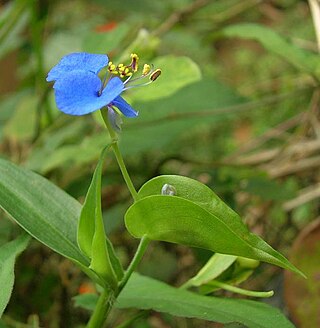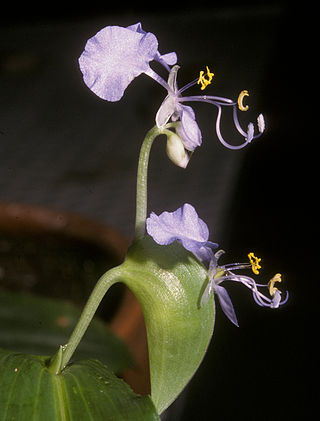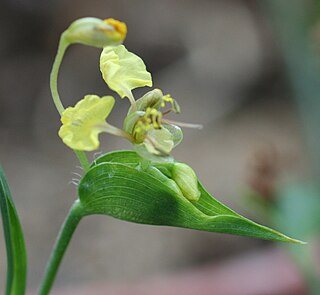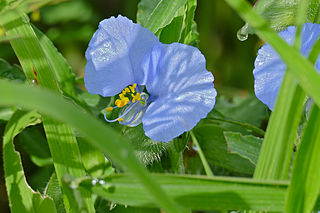
Commelina is a genus of approximately 170 species commonly called dayflowers due to the short lives of their flowers. They are less often known as widow's tears. It is by far the largest genus of its family, Commelinaceae. The Swedish taxonomist Carl Linnaeus of the 18th century named the genus after the two Dutch botanists Jan Commelijn and his nephew Caspar, each representing one of the showy petals of Commelina communis.

Commelinaceae is a family of flowering plants. In less formal contexts, the group is referred to as the dayflower family or spiderwort family. It is one of five families in the order Commelinales and by far the largest of these with about 731 known species in 41 genera. Well known genera include Commelina (dayflowers) and Tradescantia (spiderworts). The family is diverse in both the Old World tropics and the New World tropics, with some genera present in both. The variation in morphology, especially that of the flower and inflorescence, is considered to be exceptionally high amongst the angiosperms.

Commelina tuberosa is an herbaceous perennial plant in the dayflower family which is native to Mexico but grown worldwide as an ornamental plant. It is characterized by its purple-splotched spathes with free margins, its bright blue petals of equal size, its tuberous roots, and its four to ten flowered lower cymes. In the wild, it is encountered in moist fields, open forests, or pine-oak forests. The species is sometimes considered to include the species Commelina coelestis, Commelina dianthifolia, and Commelina elliptica, such as in the Flora Mesoamericana. When these are treated as separate, they are often referred to as the "Commelina tuberosa complex". Horticulturally, the species are often treated as separate entities because of their differing habits and leaf shapes. In this sense, Commelina tuberosa is a low-growing plant with long narrow leaves.

Commelina communis, commonly known as the Asiatic dayflower, is an herbaceous annual plant in the dayflower family. It gets its name because the blooms last for only one day. It is native throughout much of East Asia and northern parts of Southeast Asia. In China, the plant is known as yazhicao, roughly translating to "duckfoot herb", while in Japan it is known as tsuyukusa, meaning "dew herb". It has also been introduced to parts of central and southeastern Europe and much of eastern North America, where it has spread to become a noxious weed. It is common in disturbed sites and in moist soil. The flowers emerge from summer through fall and are distinctive with two relatively large blue petals and one very small white petal.
The Wandering Jew is a character from Christian legend.

Commelina diffusa, sometimes known as the climbing dayflower or spreading dayflower, is a pantropical herbaceous plant in the dayflower family. It has been introduced to the southeastern United States where it is most common in wet disturbed soils. There are two recognised varieties, one being the type and the other being C. diffusa var. gigas, which is native to Asia and has been introduced to Florida. It flowers from spring to fall and is most common in disturbed situations, moist places and forests. In China the plant is used medicinally as a febrifuge and a diuretic. A blue dye is also extracted from the flower for paints. In the Hawaiian Islands, it is known as "honohono grass", although it is technically not a grass. "Honohono" refers to the alternating structure of the leaves. At least one publication lists it as an edible plant in New Guinea.

Commelina caroliniana, sometimes known as the Carolina dayflower, is an herbaceous plant in the dayflower family native to India and Bangladesh. Both the scientific name and the common name are misleading as the plant was described based on specimens found in the southeastern United States before it was known that the plant had in fact been introduced from India. It was most likely introduced to South Carolina in the late 17th century along with rice seed from India. The plant has also been recently reported from South Korea. Its flowers emerge from summer to fall and rarely into the winter.

Commelina erecta, commonly known as the white mouth dayflower, slender dayflower, or widow's tears, is a perennial herb native throughout the Americas, Africa and western Asia. It is considered to be the most variable species of Commelina in North America.

Commelina benghalensis, commonly known as the Benghal dayflower, tropical spiderwort, or wandering Jew, kanshira in Bengali, is a perennial herb native to tropical Asia and Africa. It has been widely introduced to areas outside its native range, including to the neotropics, Hawaii, the West Indies and to both coasts of North America. It has a long flowering period, from spring to fall in subtropical areas, and throughout the year closer to the equator. It is often associated with disturbed soils.

Commelina cyanea, commonly known as scurvy weed, is a perennial prostrate herb of the family Commelinaceae native to moist forests and woodlands of eastern Australia, Lord Howe Island and Norfolk Island. The blue flowers appear over the warmer months and are pollinated by bees and flies.

The angulate tortoise is a species of tortoise found in dry areas and coastal scrub vegetation in South Africa. This tortoise is the only known member of the genus Chersina.

Commelina lukei is a monocotyledonous, herbaceous plant in the dayflower family from East Africa. This blue-flowered herb has been recorded in lowland areas of Kenya, Tanzania, and Madagascar, where it is found in a variety of habitats ranging from forests to grasslands to roadsides. Described in 2008, the species was previously confused with Commelina mascarenica and Commelina imberbis. Despite this misinterpretation, a third similar species, Commelina kotschyi, is actually most closely related to C. lukei. The plant's distinctive features include a scrambling habit, capsules with a rounded extension at the apex, appendaged seeds, clasping leaf bases throughout, and solely needle-like hairs along the upper side of the leaf's midrib. The species was named in honour of the botanist W. Q. R. Luke, whose collection of the plant served as the type specimen and allowed for a complete illustration and description.
Commelina kotschyi is a monocotyledonous, herbaceous plant in the dayflower family from Africa and India. This annual, blue-flowered plant is found primarily in seasonally waterlogged soils at relatively high elevations. The species has been largely confused in floras, often being misinterpreted as Commelina imberbis. C. kotschyi is most closely related to Commelina lukei, with which it does not overlap in distribution. C. kotschyi is characterised by its appendaged seeds, capsules with a bulging apex, and undulate leaves, among other features.
Commelina sphaerorrhizoma is a monocotyledonous, herbaceous plant in the dayflower family from south-central Africa. This blue-flowered herb has been recorded from western Zambia, central Angola, and the southern portion of the Democratic Republic of the Congo, although at the time of its description it was known only from 11 collections and may be more broadly distributed. It is found in a variety of habitats ranging from woodlands to grasslands to roadsides. The plant's most distinctive feature and the source of its scientific name is its moniliform rhizome composed of spherical segments that can form a bead-like chain. Other distinguishing characteristics include glaucous leaves with clasping bases, unfused and virtually hairless spathes, capsules composed of three, one-seeded locules, and very large seeds with a hairy surface.
Commelina orchidophylla is a monocotyledonous, herbaceous plant in the dayflower family from south-central Africa. This blue-flowered herb has been recorded only from the Haut-Katanga District of the Democratic Republic of the Congo, although at the time of its description it was known only from 3 collections. It is found in woodlands, especially in rocky areas, and on sandstone. The plant's most distinctive feature and the source of its scientific name is its orchid-like pair of broad basal leaves. Other distinctive characteristics include hairy tuberous roots, solitary spathes on long stalks that arise directly from the basal leaves before the development of elongated flowering shoots, dimorphic seeds, and unfused spathes lacking hairs which contain an upper cincinnus that barely emerges. The flowers have never been observed directly and are only partially known from bud dissections.

Commelina fluviatilis is an herbaceous plant in the dayflower family found primarily in Central Africa. It is known from Tanzania, the Democratic Republic of the Congo, Zambia, and the Caprivi Strip region of Namibia.

Commelina welwitschii is an herbaceous plant in the dayflower family found in Southern Africa from Zimbabwe to Angola. A phylogenetic study based on the nuclear ribosomal DNA region 5S NTS and the chloroplast region trnL-trnF, two commonly used gene regions for determining relationships, revealed that Commelina welwitschii forms a clade with Commelina purpurea and Commelina fluviatilis. Both of these relatives are African, share an unusual leaf anatomy, and have linear leaves that are often folded. Although it has yellow flowers, this study did not find a close relationship with Commelina capitata or Commelina africana, the two other African yellow-flowered species. Robert Faden, an expert on the Commelinaceae, points out that Commelina welwitschii is one of only three species in the genus to have bead-like rhizomes along with Commelina crassicaulis and Commelina sphaerorrhizoma. While it is clear that the former species is most likely a close relative given its many other similarities, the latter species is unlikely closely related given major differences in other characters.
Commelina hockii is an herbaceous plant in the dayflower family found primarily in Central Africa, from southwestern Tanzania in the east, west through the Democratic Republic of the Congo and Zambia, and possibly extending further west to Angola. The species' distinctive features include its long, tapering spathes with unfused margins, its white flowers, and its many-flowered lower cymes. It can be found in grasslands and Brachystegia-dominated woodland. It is fairly unusual among Commelina species in having variation in the color of the antherodes, with some individuals having entirely yellow antherodes, while others contain a dark spot in the center. Also, it is one of the only Commelina species known to leave a papery residue of dried fluid inside its spathes; normally only fused-spathe species are known to produce this substance. Only one specimen from Angola resembles this species, but it has blue flowers, suggesting it may be a poorly understood and as-yet undescribed separate species. Commelina hockii is probably closely related to Commelina kituloensis, which shares a similar fruit type, the same tufted perennial habit, similar large spathes with dried fluid substance, and equally numerously flowered inflorescences. That species differs in having purplish flowers, hairy leaves, shorter spathes, and a preference for high altitude grassland.

Commelina eckloniana is an herbaceous plant in the dayflower family with a broad distribution in Central and East Africa.














